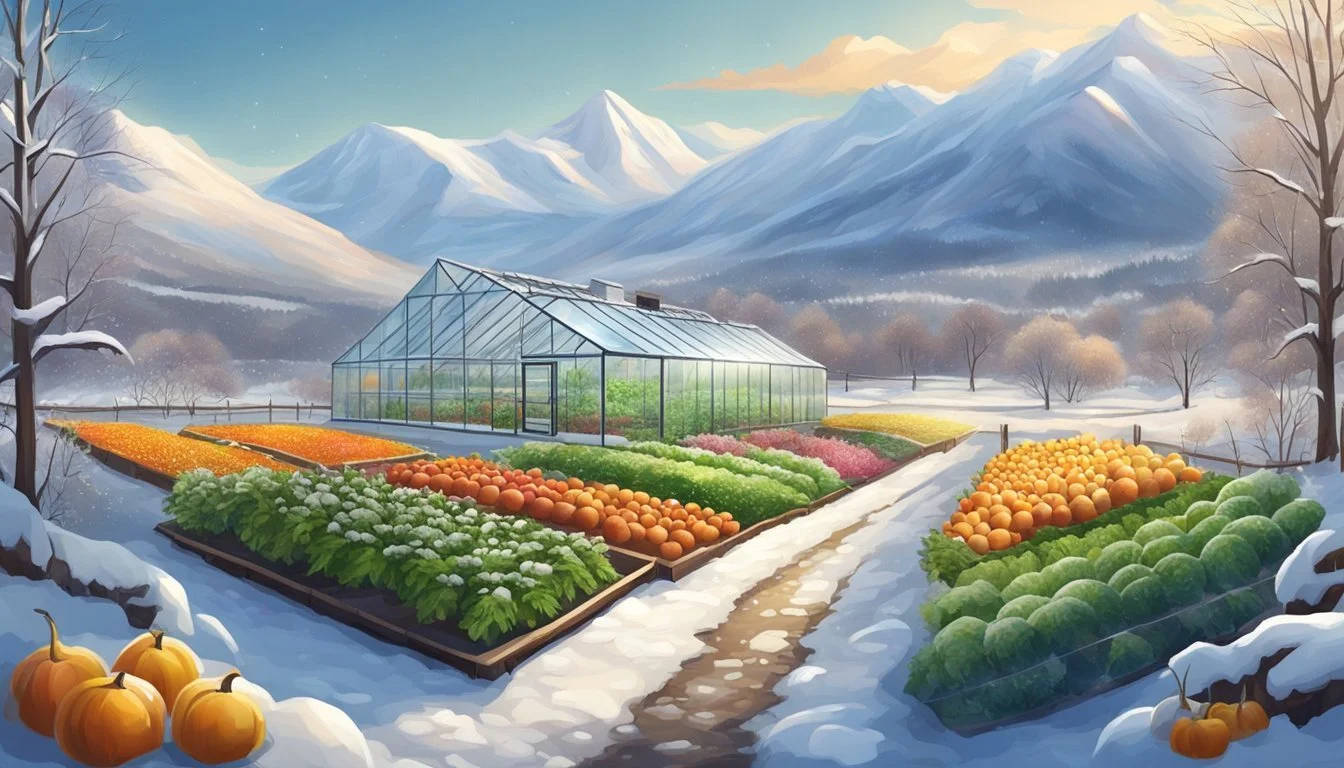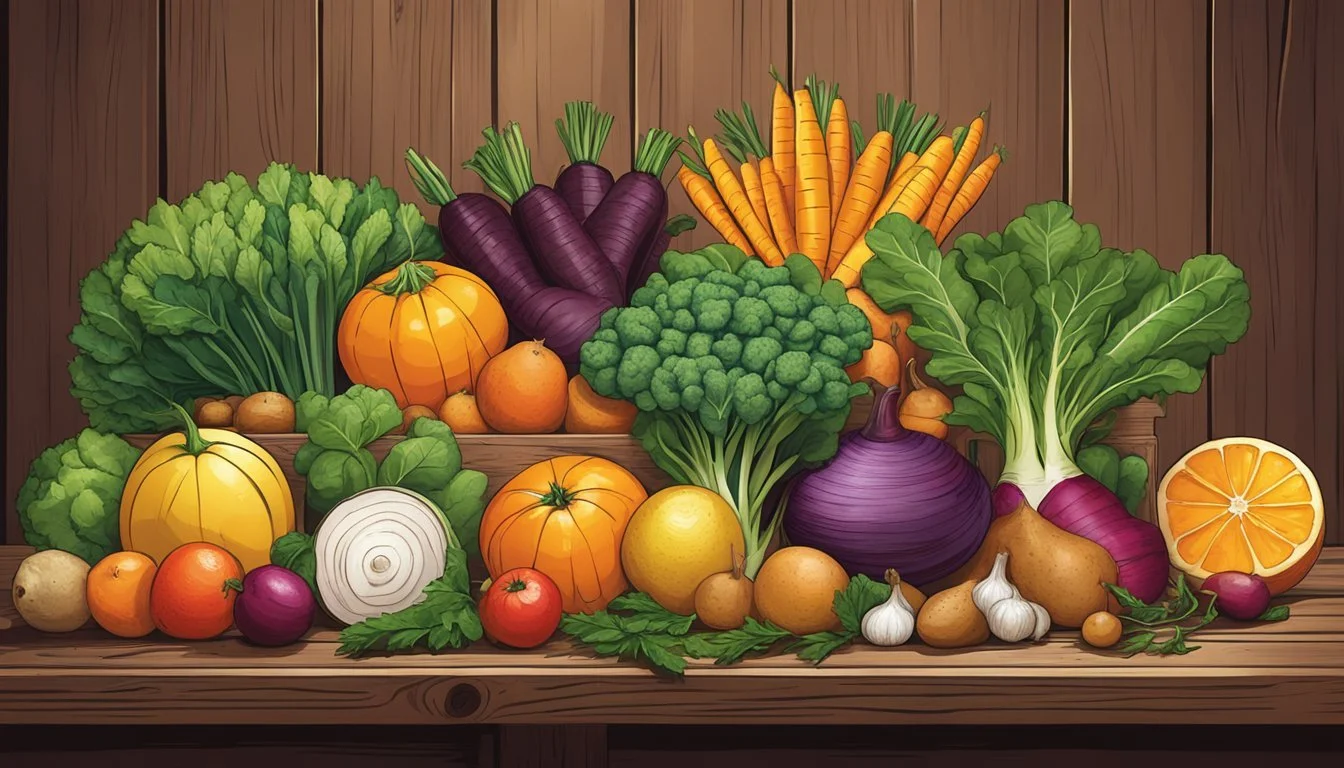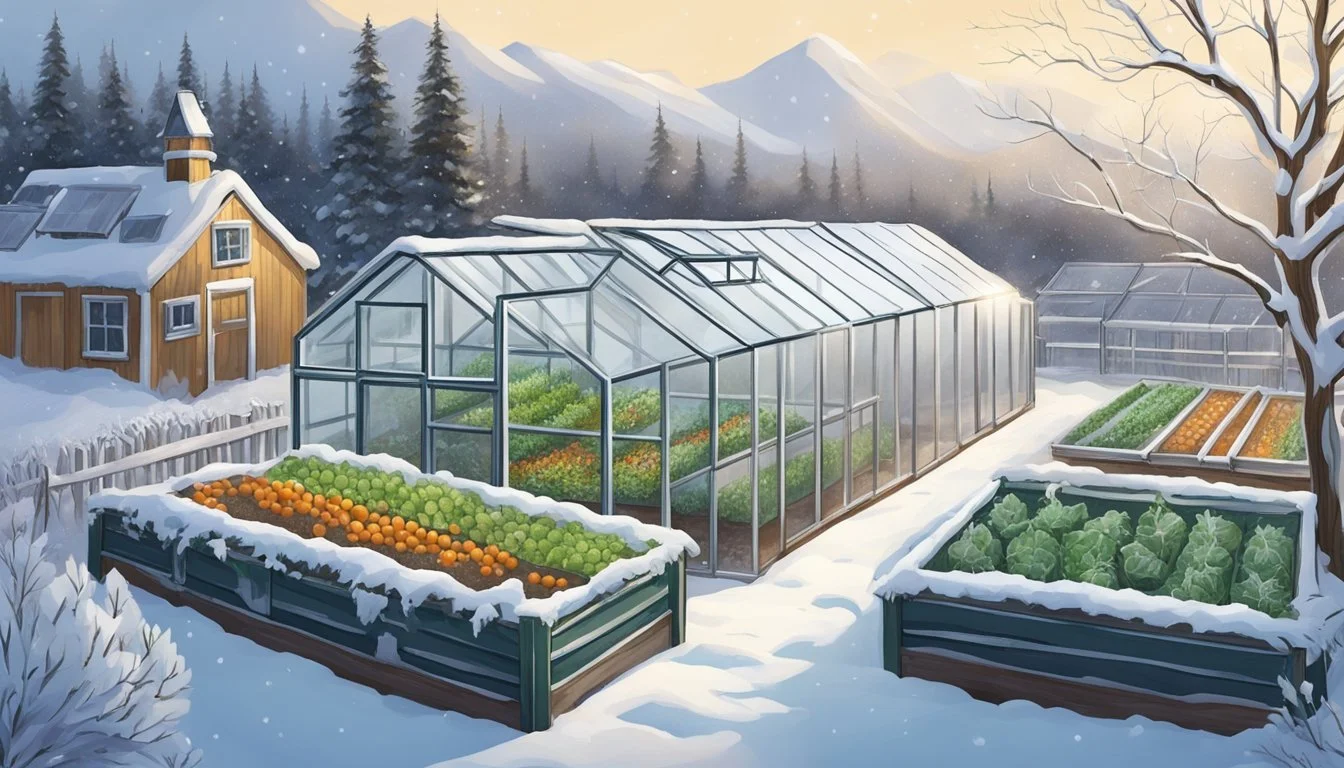Alaska Seasonal Fruit & Vegetables Guide for January
What's Fresh?
This Article is Part of our Alaska Seasonal Fruit & Veg Calendar
In the depths of January, Alaska's landscape is predominantly covered in snow, and the days are short, making growing conditions challenging for most produce. Despite these conditions, the local food economy remains active, with limited but valuable produce available. Locals and enthusiasts looking for fresh fruits and vegetables during this time rely on hearty winter crops that can be stored from previous seasons or on those that thrive in the cold climate.
Seasonal eating in Alaska during January focuses on stored root vegetables and hardy greens that can withstand harsh conditions. One can expect to find produce like potatoes, carrots (how long do carrots last?), and cabbages, which are staples due to their ability to be cellared. While fresh fruits are scarce, this time of year calls for the use of preserved goods from the bountiful summer months, such as jams and canned berries.
Incorporating these seasonal offerings into the diet not only supports local growers but also ensures a higher nutritional content and better flavor. Alaskans have adapted to their environment by choosing produce that grows well in the short summer season and stores easily through the winter, making January a month of ingenuity and appreciation for the hardy produce that can be enjoyed despite the cold.
Understanding Alaska's Unique Growing Conditions
Alaska presents distinctive climate and soil conditions that significantly impact its agricultural potential. While the growing season is notably short, the right strategies and plant choices can lead to successful gardening.
Climate and Weather Patterns
Alaska endures extreme weather conditions that are pivotal to understanding its growing environment. Winter dominates the calendar with long, harsh conditions, and the state's climate ranges from the cold, humid southeast to the polar north. The brief summer brings nearly continuous daylight, leading to a unique phenomenon where plants have accelerated growth. However, gardeners must be cognizant that the average frost-free growing season spans only about 100 days.
Notable climate characteristics:
Winter: Prolonged with heavy snow and ice
Summer: Short yet with intense periods of sunlight
Temperature Ranges: Varies greatly across regions
Soil and Agriculture
Soil conditions in Alaska can be challenging due to permafrost and varying composition. Agriculture requires meticulous soil preparation to enhance fertility and ensure proper drainage. Adjusting soil pH to neutral levels is beneficial for most vegetables and introducing organic matter can improve soil quality.
Key factors for agricultural soil preparation:
Frost: Considerable ground freeze necessitating raised beds or greenhouses
Soil Composition: Ranging from silty loams to peat soils
Maintenance: Regular amending with compost or fertilizers to replenish nutrients
These growing conditions necessitate that cultivators select cold-hardy plants and implement protective measures like season extenders to navigate the short but intense Alaskan growing period.
Seasonal Produce Overview
In the depth of winter, January offers a unique array of fruits and vegetables in Alaska. Eating seasonally ensures the consumption of produce at its peak in both flavor and nutrition.
Significance of Eating Seasonally
Eating seasonally is crucial as it aligns with nature's calendar to provide fruits and vegetables at their optimal taste and nutritional content. It also supports local farming communities, reduces the environmental impact associated with long-distance transportation, and often results in economic benefits by purchasing local produce when it's abundant and therefore, more affordable.
January Availability
In January, Alaskans can expect a limited but distinctive selection of seasonal produce. Weather conditions heavily influence the availability and may cause variations.
Fruits:
Availability is generally restricted due to the harsh Alaskan winters. Often, fruits are sourced from cold storage or imported.
Vegetables:
Root vegetables are commonly available due to their ability to be stored after fall harvest.
Examples include:
Potatoes
Carrots
Beets
Hearty winter greens may still be available from local growers who use greenhouses.
Examples include:
Cabbage
This guide reflects a general pattern of availability and consumption during January in Alaska, helping individuals plan their food choices with the season.
Winter Harvest
In January, Alaskans can find a bounty of hardy vegetables that survive the cold climate and offer rich nutrients. These include a selection of root vegetables and robust greens that are key to seasonal dishes during the darker months.
Root Vegetables
Root vegetables are well-suited to the Alaskan climate due to their ability to store energy in their roots, allowing them to thrive in cooler temperatures and be harvested in the winter. The most commonly available root vegetables during this season are:
Carrots: Sweet and crunchy, these are a staple in Alaskan winter cuisine.
Turnips: Offering a slightly peppery flavor, turnips are versatile for cooking.
Rutabagas: Similar to turnips, rutabagas are slightly sweeter and perfect for stews.
Root vegetables in Alaska are typically harvested before the deep freeze and stored in cold, humid conditions to extend their availability through the winter months.
Hardy Greens
Despite the harsh winters, some green vegetables manage to flourish in January in Alaska:
Kale: One of the most cold-resistant greens, kale is a nutritional powerhouse.
Winter Squash: While not a leafy green, winter squash is a hardy vegetable that stores well into winter and provides a rich, sweet flavor to a variety of dishes.
These vegetables are hardy enough to withstand frost, and some, like kale, even become sweeter after exposure to cold temperatures. They are a testament to the resilience of seasonal produce and form an essential part of the winter harvest in Alaska.
Fruits Available in January
In January, Alaska's fruit selection is limited due to the cold climate, but consumers can still enjoy a variety of citrus fruits that are in season during this month.
Citrus Fruits
Citrus fruits are a bright spot in Alaskan winters, with their peak availability providing a burst of freshness and vitamin C. These fruits are typically imported from warmer regions where they are in season.
Oranges: Known for their sweet and tangy flavor, oranges are a staple citrus fruit available in January. They offer versatility and can be consumed fresh, juiced, or used in a variety of recipes.
Lemons: With their sharp, sour taste, lemons are a key ingredient in many dishes, providing acidity and brightness. They are also a popular choice for lemonade or as a garnish.
Grapefruit: This fruit is larger in size, ranging from slightly tart to semi-sweet, and can be enjoyed fresh or in fruit salads (What wine goes well with salads?).
It's important for consumers to note that while pomegranates are a popular winter fruit, they typically wind down in availability by January, making them less common in Alaska at this time.
Storing and Preservation
Proper storage and preservation are critical for extending the life of Alaska's seasonal produce into the winter months. This ensures that even when the ground is frozen, Alaskans can enjoy the tastes of their local harvests.
Techniques for Extending Freshness
Root Vegetables: For root vegetables such as rutabagas, common in January, cool and humid conditions are ideal. They should be stored in perforated plastic bags in the refrigerator or in a root cellar. Citrus fruits, not native but available, need a cool, well-ventilated space. They can be kept in the fridge or a cool pantry, preventing spoilage and retaining nutrients.
Refrigeration: Place produce in the crisper drawer of the fridge.
Root Cellar Storage: Ideal for root vegetables; maintain temperatures just above freezing, with high humidity.
Ventilation: Ensure that citrus fruits have enough air circulation to prevent mold.
Canning and Pickling
Canning and pickling are traditional methods of preserving fruits and vegetables that extend their shelf life and allow for out-of-season enjoyment. Recipes for canning and pickling are plentiful, but it's vital to follow USDA guidelines for food safety.
Canning: Use a water bath for acidic foods and a pressure canner for low-acid foods.
Pickling: Both root vegetables and citrus fruits can be pickled. Use a vinegar solution, and consider adding herbs and spices for flavor.
By following these methods, individuals can successfully store and preserve seasonal foods for use in a variety of recipes throughout the year.
Health Benefits of Seasonal Produce
Consuming seasonal produce during its peak in January provides not only freshness but also a higher content of vitamins and minerals. These nutritional qualities can bolster the body's defense mechanisms during colder months.
Nutritional Content
Kale, broccoli (how long does broccoli last?), cabbage, cauliflower, and Brussels sprouts are all cruciferous vegetables readily available in January in Alaska. They are dense in nutrients such as:
Vitamins: A, C, and K
Minerals: Iron, potassium, and magnesium
Fiber: Important for digestive health
These vegetables have become well-regarded for their nutritional benefits which contribute to maintaining a well-rounded diet.
Immune-Boosting Properties
The immune system benefits greatly from the vitamins and minerals found in January's seasonal produce. Specifically:
Vitamin C: An antioxidant found abundantly in kale and broccoli, it supports the immune system and aids in the repair of all body tissues.
Vitamin A: Present in kale, this vitamin is key for maintaining vision and promoting the health of the skin and mucous membrane, serving as an immune system barrier.
Through the consumption of these nutrient-rich vegetables, the body is better equipped to ward off illnesses, particularly in the cold season.
Creative Seasonal Recipes
In the Alaskan January, when the produce selection leans towards hardy winter vegetables and storage fruits, one's culinary creativity can transform these ingredients into warming dishes that are both nourishing and satisfying.
Winter Stews and Soups
Stew with kale and winter squash emerges as a robust option for those seeking comfort during the cold months. One can simmer chunks of winter squash, carrots, and turnips in a savory broth until tender. Adding shredded kale towards the end of cooking preserves its nutrients and adds a pop of color.
A soup featuring broccoli and rice can be both hearty and heartwarming. Broccoli florets can be sautéed with garlic and onions, then combined with vegetable stock and cooked rice. Pureeing part of the soup creates a creamy texture without the need for heavy cream.
Side Dishes and Salads
For side dishes, roasted carrots and turnips showcase the natural sweetness of these root vegetables when caramelized. One might drizzle them with a balsamic glaze for added depth of flavor.
A salad utilizing the earthy flavors of kale as a base can become a standout dish with the addition of thinly sliced apples or pears for sweetness and walnuts (how long do walnuts last?) for crunch. A lemon vinaigrette dressing can balance the salad's flavors and add a fresh brightness to the earthy kale.
Local Alaskan Resources
Alaska offers a range of local resources for obtaining seasonal fruits and vegetables, even in the cooler months. These resources emphasize sustainable agriculture and support the local economy, providing residents and visitors with fresh, locally grown produce.
Farmers Markets
In January, Farmers Markets in Alaska are less common due to the harsh winter conditions. However, they play a crucial role during their operational seasons, and many offer cold storage items year-round. They serve as key points of sale for local growers and can be a source for winter-hardy produce or stored goods. Consumers can refer to the Alaska Department of Environmental Conservation for a guide to winter market operations within the state.
Community Supported Agriculture (CSA)
Community Supported Agriculture (CSA) is vital for Alaskans seeking fresh, local produce. Several farms offer CSA winter shares, which may include stored vegetables like potatoes, carrots, and cabbage, along with greenhouse-grown items. CSA programs like those from Four Winds Farm and Arctic Harvest coordinate with various locations, providing a regular supply of produce throughout the state's cities. They also offer the convenience of pickup points across Alaska, including major cities such as Anchorage and Palmer.
Gardening Tips for Alaskan Growers
In Alaska, January's frigid weather dictates that gardening activities focus largely on indoor preparations and planning for the brief but intense spring and summer growing seasons. Gardeners must strategically utilize indoor spaces to nurture seedlings and must prepare for the soil work and planting that unfolds with the thaw.
Indoor Gardening
Gardening in Alaska during January is primarily an indoor affair due to the harsh outdoor climate. Gardeners should ensure their seed starting area is ready with adequate light and warmth. Seedling heat mats and grow lights are invaluable tools for maintaining consistent temperatures and light exposure. Starting vegetables like cabbage, broccoli, and cauliflower indoors can lead to an early bounty come springtime. These plants generally require six to eight weeks before transplanting, making late winter an ideal time to begin.
Light: Aim for 14-16 hours of artificial light per day.
Temperature: Maintain soil temperature between 65°F and 75°F for optimal germination.
Gardeners should carefully monitor moisture levels of the soil to foster seedling growth without encouraging mold or mildew. They should also experiment with different seed varieties to discover which types exhibit the best growth and taste under indoor conditions.
Getting Ready for Spring
Alaskan gardeners understand that a key aspect of winter gardening is preparing for the spring. As the thaw approaches, one must plan the outdoor garden plot meticulously. Reviewing weather patterns and soil conditions can help in deciding the optimal time for transferring the indoor-started plants to the ground.
Soil testing: This is crucial for determining pH and nutrient levels, allowing for proper amendment before planting.
Garden layout: Plan for crop rotation to maintain soil health and prevent pest buildup.
Furthermore, they should be ready to capitalize on the warming weather by preparing cold frames or tunnels to protect early plantings from lingering frost. Protection methods such as mulching can help insulate soil against unpredictable spring cold snaps. By strategically planning their spring garden in the winter, they can ensure a longer growing season and a richer taste in their homegrown produce.











